
Introducing Slate Auto: The Bare-Bones Electric Truck Revolution
The automotive world has witnessed an array of electric vehicle (EV) innovations, but Slate Auto's recent launch of its Slate Truck stands out as a bold even radical new approach to electric mobility. Backed by Amazon's Jeff Bezos, this startup has embraced a minimalist design philosophy aimed at delivering an affordable yet functional electric truck. Priced under $20,000, this model positions itself as an attractive option for middle to high-income professionals aged 35 to 55 who seek practicality over luxuries.
What Makes Slate Truck Stand Out?
The Slate Truck is designed without the bells and whistles of modern vehicles. It offers a range of approximately 150 miles on a single charge with a 57.2 kWh battery pack. For those who desire a longer journey, an 84.3 kWh option delivers a range of 240 miles. Notably, the truck has manual windows and no built-in infotainment system—an unusual yet purposeful design choice focused on reliability and repairability. This lean approach caters to consumers who prioritize functionality over flashy technology.
Customization: The Key to Personal Ownership
Slate Auto invites users to personalize their vehicles through a series of accessory kits. The "flat-pack accessory SUV Kit" allows drivers to modify their trucks into five-seaters or open-air vehicles, showcasing an innovative strategy that enhances user experience without compromising on the vehicle's primary function. This unique model offers flexibility and addresses varying consumer needs, a feature that could resonate well with fitness enthusiasts or athletes who require diverse capabilities from their vehicles.
Navigating the Challenges of EV Adoption
The move towards electric vehicles, especially at a lower price point, presents both opportunities and challenges. One significant hurdle is the availability of charging infrastructure. While the Slate Truck features a NACS charging port capable of charging up to 80% in under 30 minutes, the broader issue of charging station accessibility remains a critical factor for prospective buyers. A push from companies like Slate Auto may necessitate increased collaboration with local governments and infrastructure developers to ensure that electric truck owners have sufficient access to charging stations.
Addressing Skepticism: Does Less Mean More?
Critics often argue that minimalism in vehicle design could compromise safety or functionality. Slate Auto claims that their truck aims for a five-star crash rating, and many proponents insist that a simpler design can enhance safety feature stability through fewer technological components prone to malfunctions. This perspective encourages potential buyers to consider that a streamlined truck might offer longevity and ease of maintenance over a tech-laden vehicle, aligning with many consumer preferences toward sustainability.
Future Trends in Electric Mobility
The release of the Slate Truck exemplifies a larger trend in the electric vehicle market: a shift towards affordable, practical solutions that cater to the masses. As consumers increasingly demand value-oriented products, Slate's bold strategy could inspire traditional automakers to rethink their premium-priced approaches, signaling a new era of accessible electric mobility. The focus on vehicle customization also hints at a future where personal expression and utility can coexist in the automotive industry.
Take Action: Embrace the Electric Future
Slate Auto's introduction of the Slate Truck marks a pivotal moment for both the electric vehicle market and consumer expectations. This vehicle invites you to reconsider what you truly want from an electric truck—practicality over extravagance. If you're intrigued by the potential of a customizable, affordable EV, it might be time to explore how this vehicle fits into your lifestyle.
As the landscape of the automotive industry evolves, it presents a unique opportunity for men aged 35 to 55 to embrace the benefits of electric vehicles without sacrificing on practicality. Take a closer look at the Slate Truck, embrace its minimalistic appeal, and consider how it might serve your daily needs in this age of innovation.
 Add Row
Add Row  Add
Add 




Write A Comment